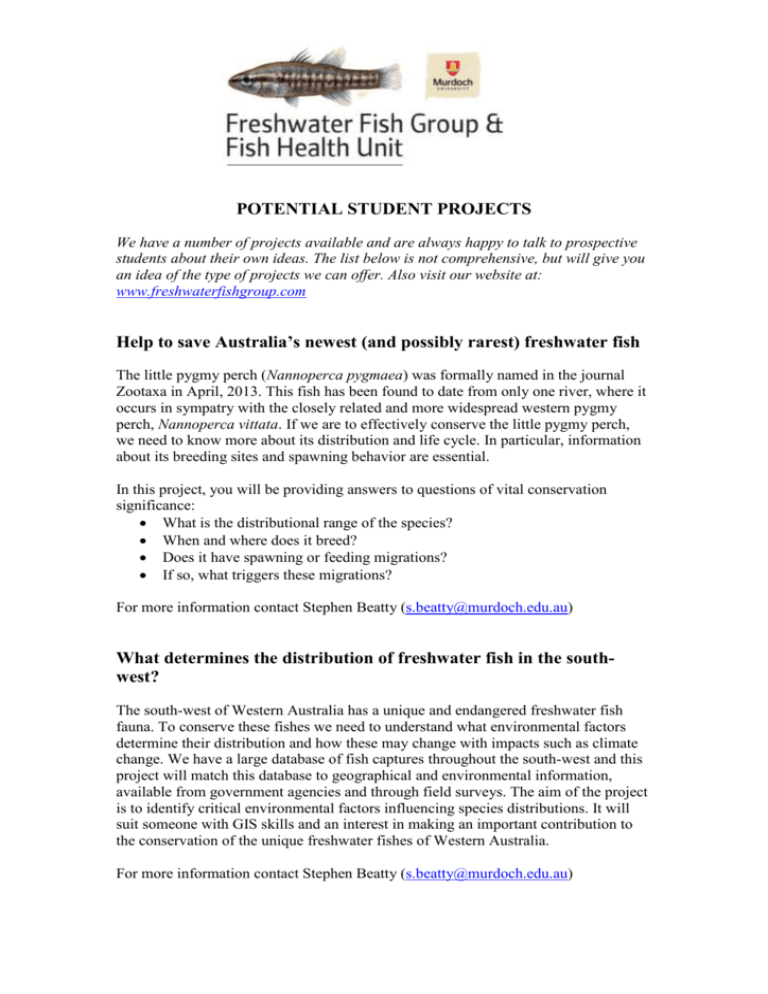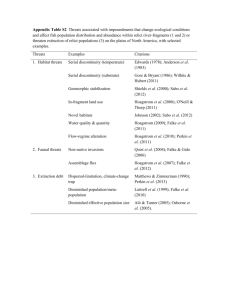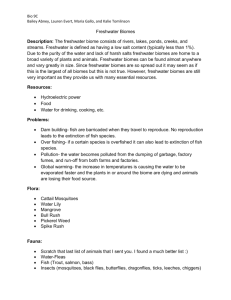Honours projects for 2009/2010
advertisement

POTENTIAL STUDENT PROJECTS We have a number of projects available and are always happy to talk to prospective students about their own ideas. The list below is not comprehensive, but will give you an idea of the type of projects we can offer. Also visit our website at: www.freshwaterfishgroup.com Help to save Australia’s newest (and possibly rarest) freshwater fish The little pygmy perch (Nannoperca pygmaea) was formally named in the journal Zootaxa in April, 2013. This fish has been found to date from only one river, where it occurs in sympatry with the closely related and more widespread western pygmy perch, Nannoperca vittata. If we are to effectively conserve the little pygmy perch, we need to know more about its distribution and life cycle. In particular, information about its breeding sites and spawning behavior are essential. In this project, you will be providing answers to questions of vital conservation significance: What is the distributional range of the species? When and where does it breed? Does it have spawning or feeding migrations? If so, what triggers these migrations? For more information contact Stephen Beatty (s.beatty@murdoch.edu.au) What determines the distribution of freshwater fish in the southwest? The south-west of Western Australia has a unique and endangered freshwater fish fauna. To conserve these fishes we need to understand what environmental factors determine their distribution and how these may change with impacts such as climate change. We have a large database of fish captures throughout the south-west and this project will match this database to geographical and environmental information, available from government agencies and through field surveys. The aim of the project is to identify critical environmental factors influencing species distributions. It will suit someone with GIS skills and an interest in making an important contribution to the conservation of the unique freshwater fishes of Western Australia. For more information contact Stephen Beatty (s.beatty@murdoch.edu.au) How well do fish swim? River barriers, such as dams and weirs, are a major threat to the unique freshwater fish fauna of Western Australia, because they prevent feeding and spawning migrations and may lead to disconnected populations. Fishways are structures which may enable fishes to negotiate these barriers and we are involved in a number of projects to design and construct fishways throughout the state. Effective fishway design, however, requires knowledge of the swimming performance of the target fishes and this information is currently very limited for native freshwater fishes in Western Australia. This study will use a swim tunnel, recently installed in our laboratory, to measure the swimming performance of freshwater fishes and relate swimming performance to parameters such as fish age, size and sex, water temperature and parasitic infection. The data that are obtained will have immediate applications because they will be related to water flow measurements from current fishways and used to design improved fishways in the future. For more information contact Stephen Beatty (s.beatty@murdoch.edu.au) Bull Sharks: recruitment and movement patterns in the Kimberley The bull shark (Carcharhinus leucas) is considered to be one of the world’s most dangerous species. This project will compare catch data of the juveniles of the species over the last few years in the Fitzroy River and implement an acoustic tracking study to determine the movement patterns (short term and long term) and habitat use. The project will suit a candidate that likes field work in remote areas and will involve Indigenous Ranger groups. For more information contact David Morgan (d.morgan@murdoch.edu.au) Freshwater Crocodiles: habitat use in small riverine pools of the Kimberley The freshwater crocodile (Crocodylus johnstoni) is an iconic species in the rivers of northern Australia. There is much concern that freshwater crocodiles will be severely impacted in the Kimberley by the invasion of the introduced cane toad (Bufo marinus). This project will assess the habitat ulitisation, home range and movement patterns of this large freshwater predator in pools of the Fitzroy River. This will be achieved through acoustic tracking and mark-recapture of the species. The project will suit a candidate that likes field work in remote areas and will involve Indigenous Ranger groups. For more information contact David Morgan (d.morgan@murdoch.edu.au) Dwarf Sawfish: recruitment and movement patterns in the Kimberley The dwarf sawfish (Pristis clavata) is critically endangered (IUCN) and is considered to be one of the world’s rarest species. The Kimberley is a hotspot for the species, yet very little is known about its biology. The candidate will be assisting in developing an acoustic tracking (passive) study in the Fitzroy River estuary and King Sound to examine the movement patterns and habitat usage of the species, and will also determine likely conservation threats. The project will suit a candidate that likes field work in remote areas and will involve Indigenous Ranger groups. For more information contact David Morgan (d.morgan@murdoch.edu.au) Is Australia free of Edwardsiella ictaluri? Edwarsiella ictaluri is a bacterium which causes significant economic losses in aquaculture catfish industries in the USA and south-east Asia. It has been detected in exotic aquarium fish species in Australia, but there has as yet been no survey of wild fishes. The aim of this project is to investigate the prevalence of E. ictaluri in freshwater catfish across northern Australia. You will work with an epidemiologist to determine an appropriate sampling program and link with catfish projects in the Kimberley, Northern Territory and north Queensland to obtain tissue samples and culture for bacteria. The data that are obtained will inform Australia’s disease freedom status for this important bacterial disease of freshwater fishes. For more information contact Susan Kueh (s.kueh@murdoch.edu.au) Study the healing process in fish gills after toxic insults Water has 30,000x less oxygen than air. Hence, fast swimming fish are very susceptible to gill damage. Algae blooms may produce substances toxic to tissues including gills. Algae blooms can be very transient, with clinical signs presenting in affected fish only 1-2days after the blooms have been washed away by currents or tides. This often makes the diagnosis of the cause of gill damage difficult without a good understanding of how gills response and heal in the period following toxic insults. Surprisingly while many published papers report on the gill damage caused by various toxic chemicals, none could be found describing the healing process that follows. The question remains: do fish gills response to toxic damage much like lung tissues in mammals and birds? This study will require you to: • Design live fish experiments to study the healing process in fish gills post exposure to toxic compounds • Carry out histopathological evaluation of gills sampled over time • Undertake ultrastructural evaluation using electron microscopy For more information contact Susan Kueh (s.kueh@murdoch.edu.au) Evaluation of in-feed essentials oils as a control for ‘Big Belly’, a gut bacterial disease of Lates calcarifer (barramundi) ‘Big Belly’ (aka Pot Belly) is a significant bacterial disease of barramundi fry at the hatchery level in Southeast Asia. ‘Big Belly’ can cause mortalities of 80 to 100%. It is caused by intracellular coccobacilli and is difficult to treat. The disease may persist as a chronic gut infection in grow-out barramundi. In this study, we are interested in incorporating the essential oils extracted from garlic, ginger, clove or cinnamon into feed as a potential means of controlling ‘Big Belly’. Similar trials carried out in rainbow trout and tilapia have shown beneficial effects including better resistance to disease. You will be involved in the following: Field & laboratory trials based in Singapore Design of experimental field trials to evaluate in-feed essential oils Evaluate the effects of these supplements via examination of test versus control fish tissues Laboratory challenge trials against pathogens For more information contact Susan Kueh (s.kueh@murdoch.edu.au) How many freshwater mussels do we have in south-western Australia? Only one species of freshwater mussel, Carter’s freshwater mussel or Westralunio carteri, is thought to occur in the south-west of Western Australia. A recently completed PhD project by Dr Michael Klunzinger found that W. carteri has undergone a massive reduction in range over the last 50 years, principally because of salinization and drying of rivers. The same project found some tantalizing evidence that certain populations of these mussels are genetically differentiated, to the extent that they may not belong to the same species. The aim of this study is to use molecular genetic and morphological analyses to determine whether there are one or more species of freshwater mussels in the southwest of Western Australia. Answering this question will have important consequences for conservation management, because it will affect both the conservation status and future management plans for freshwater mussels in the region. For more information contact Alan Lymbery (a.lymbery@murdoch.edu.au) Are mussels keystone species for freshwater ecosystems? Mussels play important roles in the functioning of freshwater ecosystems throughout the world, particularly because their filter feeding activities influence water chemistry and clarity, and the amount and kind of suspended particles in the water. Nothing is known, however, of the extent to which Carter’s freshwater mussel influences water quality in Western Australian rivers. Mussel densities can be very high ( 100 m-2) in pools which form over summer in many of the ephemeral rivers in the south-west. These pools are important refuge sites for native freshwater fishes and we hypothesise that mussels contribute to the survival of fishes in the pools through their filter feeding activities, which may reduce algal density, enhance water quality and prevent lethal deoxygenation. The aim of this study is to test this hypothesis using a combination of field observations and manipulation of mussel and fish densities in experimental ponds. For more information contact Alan Lymbery (a.lymbery@murdoch.edu.au) Are introduced parasites a threat to our native fishes? Introduced fish species may impact native fishes directly, through predation and competition, or indirectly, by bringing with them new diseases. We have recently discovered in the south-west the exotic parasite Lernaea cyprinacea, which was probably introduced with goldfish and carp. This parasite appears to be both more prevalent and more virulent in native fish species than in its original host species. Understanding why this is will help us to control them. The principal aim of this project is to answer the following questions: (1) Does the parasite infect native fishes more readily because of the fishes’ behaviour? (2) Are native fishes less able than goldfish to mount an effective immune response? (3) Do native fishes show a greater pathogenic reaction to the presence of the parasite? For more information contact Alan Lymbery (a.lymbery@murdoch.edu.au)





